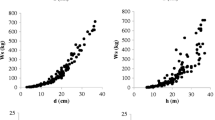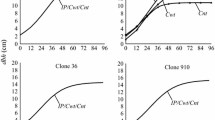Abstract
Planting mallee-form eucalypts amongst crops has the potential to remedy environmental degradation caused by land clearing in low rainfall regions, whilst also providing income through carbon-sequestration or periodic coppicing. Management options can be supported by models of biomass and coppice recovery, and this paper presents the first empirical coppice growth model for mallee eucalypts. Uncoppiced and coppiced belt-planted Eucalyptus polybractea, E. loxophleba and E. kochii were harvested and roots excavated to provide estimates of shoot and root biomass for analysis and model development. Allometric models of shoot biomass were appropriate for both uncoppiced and coppiced trees, but models of root/total biomass ratio for coppice depended on site quality and age, and could not be modelled allometrically. Mean root/total biomass proportions for uncoppiced trees were estimated (with standard errors) to be 0.38 (0.009), 0.50 (0.031), and 0.46 (0.021) for E. polybractea, E. loxophleba, and E. kochii respectively and were sensitive to site quality but insensitive to age. The time taken to regain pre-coppice shoot biomass was about half that of full pre-cut root/total biomass ratio recovery, and was affected by coppicing age and site quality. A conceptual model of coppice growth indicated that coppiced stands may produce more total biomass than uncoppiced stands of the same age.







Similar content being viewed by others
Change history
05 February 2024
A Correction to this paper has been published: https://doi.org/10.1007/s11056-023-10024-8
References
Babu J, Harendra NP, Radhey ST (2001) Vertical distribution and seasonal changes of fine and course root mass in Pinus kesiya Royle Ex. gordon forest of three different ages. Acta Oecologica 22:293–300
Bartle J, Olsen G, Cooper D, Hobbs T (2007) Scale of biomass production from new woody crops for salinity control in dryland agriculture in Australia. Int J Global Energy Issues 27(2):115–137
Bartle JR, Abadi A (2010) Toward sustainable production of second generation bioenergy feedstocks. Energy Fuels 24(1):2–9. https://doi.org/10.1021/ef9006438
Barton CVM, Montagu KD (2006) Effect of spacing and water availability on root:shoot ratio in Eucalyptus camaldulensis. For Ecol Manage 221(1–3):52–62. https://doi.org/10.1016/j.foreco.2005.09.007
Bloom AJ, Chapin FS, Mooney HA (1985) Resource limitation in plants - an economic analogy. Annu Rev Ecol Syst 16:363–392
Brooksbank K (2011a) Hydrological impacts and productivity interactions of integrated oil mallee farming systems: Landscape scale effect of dispersed mallee plantings. RIRDC,
Brooksbank K (2011b) Oil Mallees: Physiology and growth under variable water availability in low rainfall agroforestry systems. University of Western Australia, Pertn
Brooksbank K, Veneklaas EJ, White DA, Carter JL (2011) The fate of hydraulically redistributed water in a semi-arid zone eucalyptus species. Tree Physiol 31(6):649–658. https://doi.org/10.1093/treephys/tpr052
Brooksbank K, White DA, Veneklaas EJ, Carter JL (2008) Effects of Depth to Water Table on Tree Growth in a Low Rainfall Agroforestry System. Paper presented at the Forestry for a better future: climate, commerce and communities, Albury, New South Wales, 2008
Caccetta P, Dunne R, George R, McFarlane D (2010) A methodology to estimate the future extent of dryland salinity in the Southwest of Western Australia. J Environ Qual 39(1):26–34. https://doi.org/10.2134/jeq2009.0037
Cairns M, Brown S, Helmer E, Baumgardner G (1997) Root biomass allocation in the world’s upland forests. Oecologia 111(1):1–11
Carter R, Mendham D, Sudmeyer R, Rose15 B, Butler16 D, Cohen17 L, Fairman T, Law R, Finn B, Brammar M (2013) Improved estimation of biomass accumulation by environmental plantings and mallee plantings using FullCAM
Casper BB, Schenk HJ, Jackson RB (2003) Defining a plants belowground zone of influence. Ecology 84(9):2313–2321
Cooper D, Olsen G, Bartle J (2005) Capture of agricultural surplus water determines the productivity and scale of new low-rainfall woody crop industries. Aust J Exp Agric 45(11):1369–1388. https://doi.org/10.1071/EA04152
Cromer R, Jarvis P (1990) Growth and Biomass partitioning in <I>Eucalyptus grandis</I> seedlings in response to nitrogen supply. Funct Plant Biol 17(5):503–515. https://doi.org/10.1071/PP9900503
George RJ (1991) Management of sandplain seeps in the wheatbelt of Western Australia. Agric Water Manag 19:85–104
George RJ, Nulsen RA, Ferdowsian R, Raper GP (1999) Interactions between trees and groundwaters in recharge and discharge areas - a survey of Western Australian sites. Agric Water Manag 39:91–113
Holzworth DP, Huth NI, deVoil PG, Zurcher EJ, Herrmann NI, McLean G, Chenu K, van Oosterom EJ, Snow V, Murphy C, Moore AD, Brown H, Whish JPM, Verrall S, Fainges J, Bell LW, Peake AS, Poulton PL, Hochman Z, Thorburn PJ, Gaydon DS, Dalgliesh NP, Rodriguez D, Cox H, Chapman S, Doherty A, Teixeira E, Sharp J, Cichota R, Vogeler I, Li FY, Wang E, Hammer GL, Robertson MJ, Dimes JP, Whitbread AM, Hunt J, van Rees H, McClelland T, Carberry PS, Hargreaves JNG, MacLeod N, McDonald C, Harsdorf J, Wedgwood S, Keating BA (2014) APSIM – Evolution towards a new generation of agricultural systems simulation. Environ Model Softw 62:327–350. https://doi.org/10.1016/j.envsoft.2014.07.009
Kuyah S, Dietz J, Muthuri C, Jamnadass R, Mwangi P, Coe R, Neufeldt H (2012) Allometric equations for estimating biomass in agricultural landscapes: II. belowground biomass. Agric, Ecosyst Environ 158:225–234. https://doi.org/10.1016/j.agee.2012.05.010
Li C, Berninger F, Koskela J, Sonninen E (2000) Drought responses of Eucalyptus microtheca provenances depend on seasonality of rainfall in their place of origin. Aust J Plant Physiol 27:231–238
Luo Y, Wang X, Zhang X, Booth TH, Lu F (2012) Root:shoot ratios across China’s forests: forest type and climatic effects. For Ecol Manage 269:19–25. https://doi.org/10.1016/j.foreco.2012.01.005
Mathews R, Robertson K (2001) Answers to ten frequently asked questions about bioenergy, carbon sinks and their role in global climate change. JOANNEUM RESEARCH, Forschungsgesellschaft mbH, Steyrergasse 17, A-8010 Graz, AUSTRIA
McFarlane DJ, George RJ, Caccetta (2004) The extent and potential area of salt-affected land in Western Australia estimated using remote sensing and digital terrain models. 1st National Salinity Engineering Conference, Perth Western Australia
Mokany K, Raison JR (2006) Critical analysis of root:shoot ratios in terrestrial biomes. Glob Change Biol 12(1):84–96
Noble JC (2001) Lignotubers and meristem dependence in mallee Eucalyptus coppicing after fire. Aust J Bot 49(1):31–41. https://doi.org/10.1071/BT00046
Pate JS, Verboom WH (2009) Contemporary biogenic formation of clay pavements by eucalypts: further support for the phytotarium concept. Ann Bot 103:673–685
Paul KI, Jacobsen K, Koul V, Leppert P, Smith J (2008) Predicting growth and sequestration of carbon by plantations growing in regions of low-rainfall in southern Australia. For Ecol Manage 254(2):205–216. https://doi.org/10.1016/j.foreco.2007.08.003
Paul KI, Larmour J, Specht A, Zerihun A, Ritson P, Roxburgh SH, Sochacki S, Lewis T, Barton CVM, England JR, Battaglia M, O’Grady A, Pinkard E, Applegate G, Jonson J, Brooksbank K, Sudmeyer R, Wildy D, Montagu KD, Bradford M, Butler D, Hobbs T (2019) Testing the generality of below-ground biomass allometry across plant functional types. For Ecol Manage 432:102–114. https://doi.org/10.1016/j.foreco.2018.08.043
Paul KI, Roxburgh SH, England JR, Brooksbank K, Larmour JS, Ritson P, Wildy D, Sudmeyer R, Raison RJ, Hobbs T, Murphy S, Sochacki S, McArthur G, Barton C, Jonson J, Theiveyanathan S, Carter J (2014) Root biomass of carbon plantings in agricultural landscapes of southern Australia: development and testing of allometrics. For Ecol Manage 318:216–227. https://doi.org/10.1016/j.foreco.2013.12.007
Paul KI, Roxburgh SH, England JR, Ritson P, Hobbs T, Brooksbank K, John Raison R, Larmour JS, Murphy S, Norris J, Neumann C, Lewis T, Jonson J, Carter JL, McArthur G, Barton C, Rose B (2013) Development and testing of allometric equations for estimating above-ground biomass of mixed-species environmental plantings. For Ecol Manage 310:483–494. https://doi.org/10.1016/j.foreco.2013.08.054
Peck A, Sudmeyer R, Huxtable D, Bartle J, Mendham DS (2012) Productivity of mallee agroforestry systems: the effect of harvest and competition management regimes. RIRDC, Canberra, Australia
Peichl M, Arain MA (2007) Allometry and partitioning of above- and belowground tree biomass in an age-sequence of white pine forests. For Ecol Manage 253(1–3):68–80. https://doi.org/10.1016/j.foreco.2007.07.003
Qadir M, Quillérou E, Nangia V, Murtaza G, Singh M, Thomas RJ, Drechsel P, Noble AD (2014) Economics of salt-induced land degradation and restoration. Nat Res Forum 38(4):282–295. https://doi.org/10.1111/1477-8947.12054
Resh S, Battaglia M, Worledge D, Ladiges S (2003) Coarse root biomass for eucalypt plantations in Tasmania, Australia: sources of variation and methods for assessment. Trees 17(5):389–399. https://doi.org/10.1007/s00468-003-0250-6
Ritson P, Sochacki S (2003) Measurement and prediction of biomass and carbon content of Pinus pinaster trees in farm forestry plantations, south-western Australia. For Ecol Manage 175(1):103–117. https://doi.org/10.1016/S0378-1127(02)00121-4
Schenk HJ, Jackson RB (2002) Rooting depths, lateral root spreads and below ground/above ground allometries of plants in water limited ecosystems. J Ecol 90:480–494
Schultze E-D (1986) Whole plant responses to drought. Aust J Plant Physiol 13:127–141
Snowdon P, Eamus D, Philip G, Khanna P, Keith H, Raison J, Kirschbaum M (2000) Synthesis of Allometrics, Review of Root Biomass and Design of Future Woody Biomass Sampling Strategies. Australian Greenhouse office, Canberra, Australia
Spencer B, Bartle J, Huxtable D, Mazanec R, Abadi A, Gibberd M, Zerihun A (2019) A decadal multi-site study of the effects of frequency and season of harvest on biomass production from mallee eucalypts. For Ecol Manage 453:117576. https://doi.org/10.1016/j.foreco.2019.117576
Stirzaker RJ, Cook FJ, Knight JH (1999) Where to plant trees on cropping land for control of dryland salinity: some appropriate solutions. Agric Water Manag 39:115–133
Wildy DT, Pate JS (2002) Quantifying above and below ground growth responses of the Western Australian Oil Mallee, eucalyptus kochii subsp plenissima, to contrasting decapitation regimes. Ann Bot 90:185–197
Author information
Authors and Affiliations
Corresponding author
Additional information
Publisher's Note
Springer Nature remains neutral with regard to jurisdictional claims in published maps and institutional affiliations.
Appendix 1
Appendix 1
Derivation of the relationship between root biomass in a 4 m3 pit (R4) and total root biomass > 2 mm (R).
(15) and (16) and (11) into (8)=>
Rearrange (13)=>
If \(LIG=0.3{R}_{4}\)
where \({R}_{}\) is total root biomass, R4 is the root biomass recovered from 4 m3 pit, \(\varphi\)=1.5, L = total lateral root biomass, T = total tap root biomass, L4 = lateral root biomass recovered within 4m3 excavation, T4 = tap root biomass recovered within 4m3 excavation, \(LIG\) =mass of lignotuber.
Rights and permissions
Springer Nature or its licensor (e.g. a society or other partner) holds exclusive rights to this article under a publishing agreement with the author(s) or other rightsholder(s); author self-archiving of the accepted manuscript version of this article is solely governed by the terms of such publishing agreement and applicable law.
About this article
Cite this article
Brooksbank, K., Goodwin, A. A model of coppice biomass recovery for mallee-form eucalypts. New Forests 53, 449–468 (2022). https://doi.org/10.1007/s11056-021-09863-0
Received:
Accepted:
Published:
Issue Date:
DOI: https://doi.org/10.1007/s11056-021-09863-0




